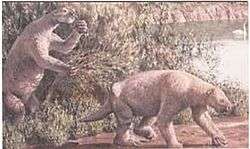Megalonyx leptostomus
| Megalonyx leptostomus Temporal range: Late Pliocene and Pleistocene | |
|---|---|
 | |
| Scientific classification | |
| Kingdom: | Animalia |
| Phylum: | Chordata |
| Class: | Mammalia |
| Superorder: | Xenarthra |
| Order: | Pilosa |
| Family: | Megalonychidae |
| Subfamily: | Megalonychinae |
| Genus: | †Megalonyx |
| Species: | †Megalonyx leptostomus Cope, 1893 |
Megalonyx leptostomus — the narrow-mouthed sloth — is an extinct species of giant ground sloth that lived in North America during the Blancan-Nebraskan ages (about 3 to 1.2 MYA) .
The name "leptostomus" comes from Greek, leptonyx = lepto (narrow), stoma (mouth); thus, Megalonyx leptostomus literally means “big claw, narrow mouth”.
Description
M. leptostomus was about half the size of the later M. jeffersonii (Jefferson’s ground sloth).
Range
M. leptostomus ranged from Washington state as far east as Florida and south through Texas into Mexico.
Fossil history
M. leptostomus was originally described from Mount Blanco, Texas, in 1893 by Edward Drinker Cope. Specimens were among the variety of fossils first collected at the Hagerman Fossil Beds in Idaho by Smithsonian field crews in the 1930s. In 1935 C.L. Gazin, the curator of vertebrate paleontology at the Smithsonian in charge of the last excavations at the Horse Quarry in 1934, wrote a scientific paper describing the fossil sloth material from Hagerman.[1] He originally referred to the Hagerman sloth as Megalonyx leptonyx. This sloth was found in Castle Creek, Owyhee County in the 1870s but is now considered to be the same as M. leptostomus. While no complete skeletons have been found at Hagerman, there have been a good variety of bones for comparison with other species of Megalonyx. These include lower jaws, isolated teeth, various leg bones and a complete hind foot.
Cladistics
M. leptostomus was probably ancestral to Wheatley's ground sloth (M. wheatleyi) (of Irvingtonian-Yarmouthian age: about 1.2 to 0.6 MYA), which in turn gave rise to the larger, later M. jeffersonii.
References
- ↑ Gazin, C.L. (1935), "Gravigrade sloth remains from the late Pliocene and Pleistocene of Idaho", Journal of Mammalogy 16(1):52-60.